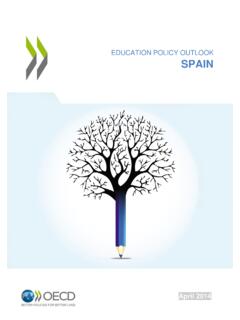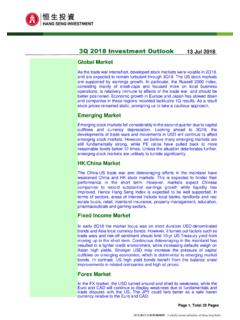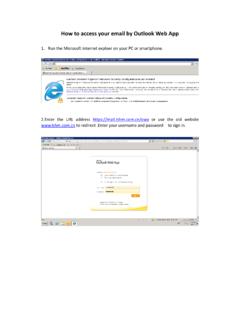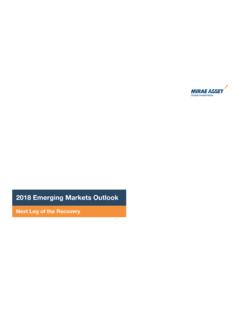Transcription of EDUCATION POLICY OUTLOOK KOREA - OECD.org
1 EDUCATION POLICY OUTLOOK . KOREA . EDUCATION POLICY OUTLOOK : KOREA OECD 2016 1. November 2016. EDUCATION POLICY OUTLOOK . This POLICY profile on EDUCATION in KOREA is part of the EDUCATION POLICY OUTLOOK series, which presents comparative analysis of EDUCATION policies and reforms across OECD countries. Building on the OECD's substantial comparative and sectorial POLICY knowledge base, the series offers a comparative OUTLOOK on EDUCATION POLICY by providing analysis of individual countries' educational context, challenges and policies ( EDUCATION POLICY profiles), analysis of international trends and insight into policies and reforms on selected topics. In addition to country-specific profiles, the series also includes a recurring publication.
2 The first volume, EDUCATION POLICY OUTLOOK 2015: Making Reforms Happen, was released in January 2015. Designed for POLICY makers, analysts and practitioners who seek information and analysis of EDUCATION POLICY taking into account the importance of national context, the country POLICY profiles offer constructive analysis of EDUCATION POLICY in a comparative format. Each profile reviews the current context and situation of the country's EDUCATION system and examines its challenges and POLICY responses, according to six POLICY levers that support improvement: Students: How to raise outcomes for all in terms of 1) equity and quality and 2) preparing students for the future. Institutions: How to raise quality through 3) school improvement and 4) evaluation and assessment.
3 System: How the system is organised to deliver EDUCATION POLICY in terms of 5) governance and 6) funding. Some country POLICY profiles contain spotlight boxes on selected POLICY issues. They are meant to draw attention to specific policies that are promising or showing positive results and may be relevant for other countries. Special thanks to Moonhee Kim and Juhui Lee from the Permanent Delegation of KOREA to the OECD ( EDUCATION POLICY OUTLOOK national co-ordinators), as well as the Ministry of EDUCATION of KOREA and the Korean Educational Development Institute for their active input during consultations and constructive feedback on this report. Authors: This country POLICY profile was prepared by Gillian Golden (main drafter) and Diana Toledo Figueroa, from the EDUCATION POLICY OUTLOOK team of the POLICY Advice and Implementation Division, led by Paulo Santiago.
4 Editorial support was provided by Susan Copeland and C lia Braga-Schich. This profile builds on the knowledge and expertise of many project teams across the OECD Directorate for EDUCATION and Skills, to whom we are grateful. Sources: This country profile draws on OECD indicators from the Programme for International Student Assessment (PISA), the Survey of Adult Skills, a product of the OECD Programme for International Assessment of Adult Competencies (PIAAC), the Teaching and Learning International Study (TALIS), and the annual publication EDUCATION at a Glance, and refers to country and thematic studies, such as OECD. work on early childhood EDUCATION and care, teachers, school leadership, evaluation and assessment for improving school outcomes, equity and quality in EDUCATION , governing complex EDUCATION systems, vocational EDUCATION and training, and tertiary EDUCATION .
5 Much of this information and documentation can be accessed through the EDUCATION GPS at Most of the figures quoted in the different sections refer to Annex B, which presents a table of the main indicators for the different sources used throughout the country profile. Hyperlinks to the reference publications are included in the text for ease of reading and also in the References and further reading section, which lists both OECD and non-OECD sources. More information is available from the OECD Directorate for EDUCATION and Skills ( ). and its web pages on EDUCATION POLICY OUTLOOK ( ). EDUCATION POLICY OUTLOOK : KOREA OECD 2016 2. TABLE OF CONTENTS. Highlights .. 4. Equity and quality: High coverage and high performance.
6 6. Preparing students for the future: Skills mismatch and strong emphasis on academic stream .. 8. School improvement: Improving learning environments for teachers and students .. 10. Evaluation and assessment: Moving towards a more holistic framework .. 12. Governance: High autonomy for institutions .. 14. Funding: Reducing the pressure on households .. 16. Annex A: Structure of KOREA 's EDUCATION system .. 18. Annex B: Statistics .. 19. References and further reading .. 22. Figures Figure 1. Student performance in mathematics, impact of ESCS and performance of adults in literacy .. 5. Figure 2. Upper secondary and tertiary attainment .. 5. Figure 3. Mathematics performance and percentage of low and top performers.
7 7. Figure 4. Percentage of 15-29 year-olds in EDUCATION and not in 9. Figure 5. School principals' and students' views on learning environment .. 11. Figure 6. Student assessments by purpose .. 13. Figure 7. Decisions in public lower secondary schools, by level of government .. 15. Figure 8. Expenditure on educational institutions as a percentage of GDP .. 17. Spotlights Spotlight 1. Meister schools .. 9. Spotlight 2. Introducing a Free Semester System in lower secondary EDUCATION .. 13. Spotlight 3. Transforming third-level admissions procedures .. 15. EDUCATION POLICY OUTLOOK : KOREA OECD 2016 3. HIGHLIGHTS. KOREA 's educational context Students: KOREA is one of the OECD's top performers in mathematics, reading and science in PISA 2012, and students' socio-economic background had less impact on 15-year-olds' performance in mathematics than in other OECD countries.
8 Compulsory EDUCATION covers primary and lower secondary levels, from age 6 to age 14. Tracking starts at age 14, the same as the OECD average, and grade repetition is rare. KOREA has some of the highest attainment rates among OECD countries in upper secondary and tertiary EDUCATION for 25-34 year-olds. The enrolment rate in vocational EDUCATION and training (VET) is below average. However, in recent years more VET students are entering the labour market, reversing the previous trend of more VET students continuing to tertiary EDUCATION . Overall, unemployment rates in KOREA are among the lowest in OECD countries, and employment rates for those with lower levels of EDUCATION are higher than average.
9 KOREA 's employment rate for those with tertiary EDUCATION is lower than the OECD average, particularly for younger age groups (25-34 year- olds and 35-44 year-olds). Institutions: Autonomy over resource allocation in Korean schools is below the OECD average, and autonomy over curriculum and assessment is among the highest in OECD countries. Primary and secondary teachers have above-average class size and below-average teaching time. Compared to the TALIS average, a higher proportion of teachers in KOREA consider that the teaching profession is valued in society, while a lower proportion of teachers would choose to work as teachers if they could decide again. The scope of the evaluation and assessment framework is broadening from student assessment to overall evaluation of the system, although some student assessments continue to have widespread social importance.
10 Teacher appraisal aims to support continuous professional development, and school evaluation includes internal and external (local and national) evaluations. System: Governance of the EDUCATION system is shared between central and local authorities. The Ministry of EDUCATION and municipal and provincial offices are responsible for primary to upper secondary EDUCATION , while higher EDUCATION is the responsibility of the Ministry of EDUCATION and councils for university and university college EDUCATION . The share of Gross Domestic Product devoted to educational institutions (for all EDUCATION levels combined) is among the highest in OECD countries, with one of the highest shares of private funding in OECD.
















